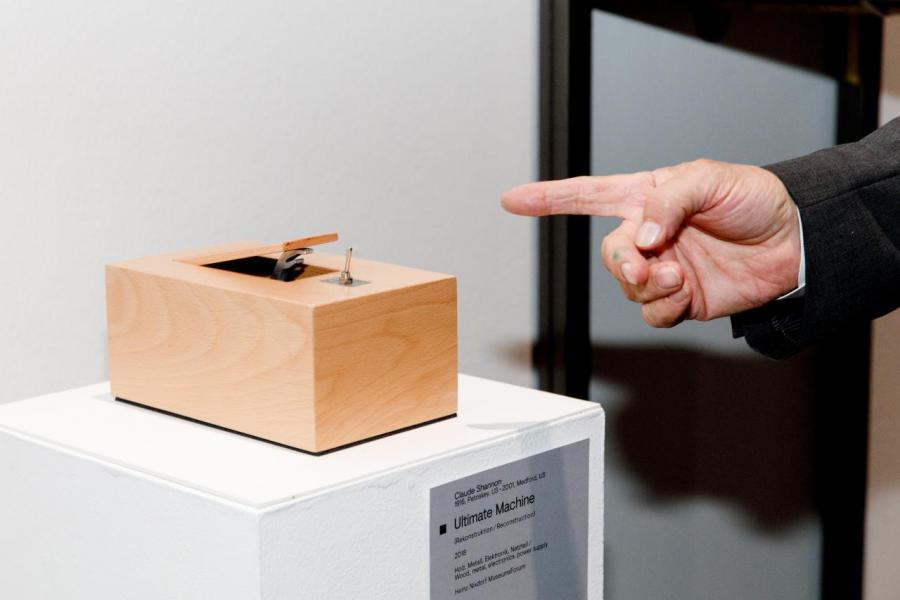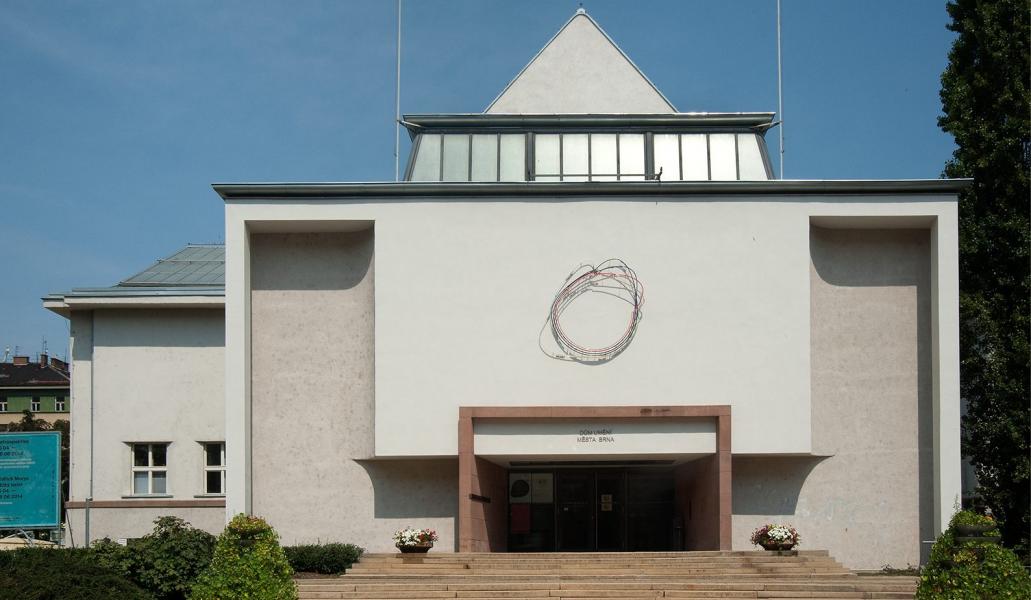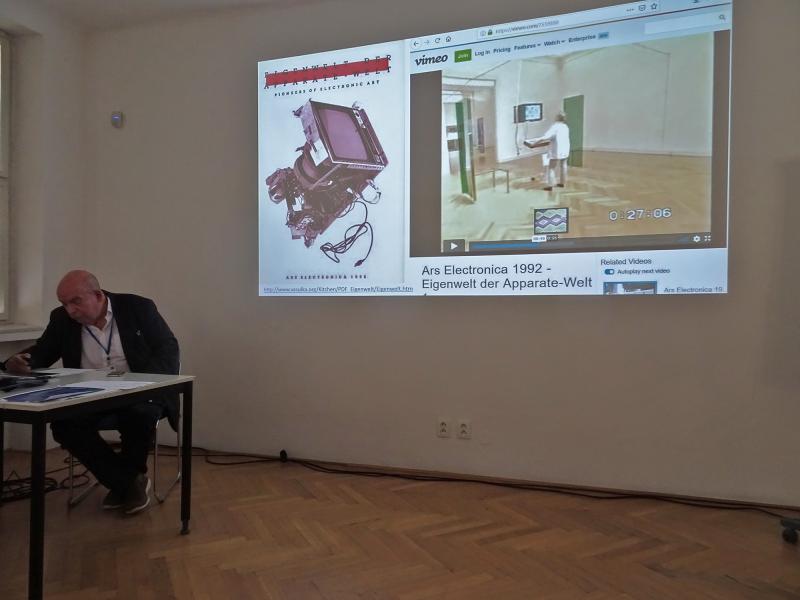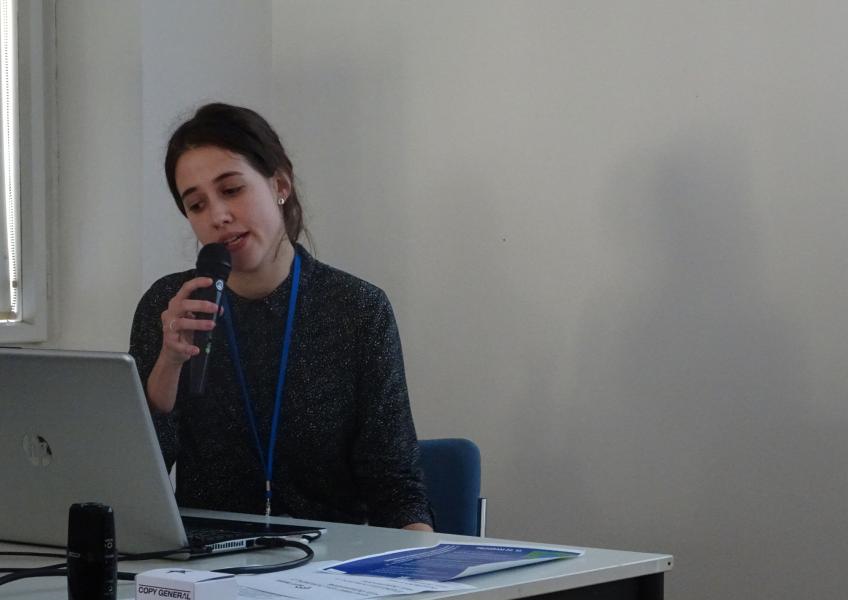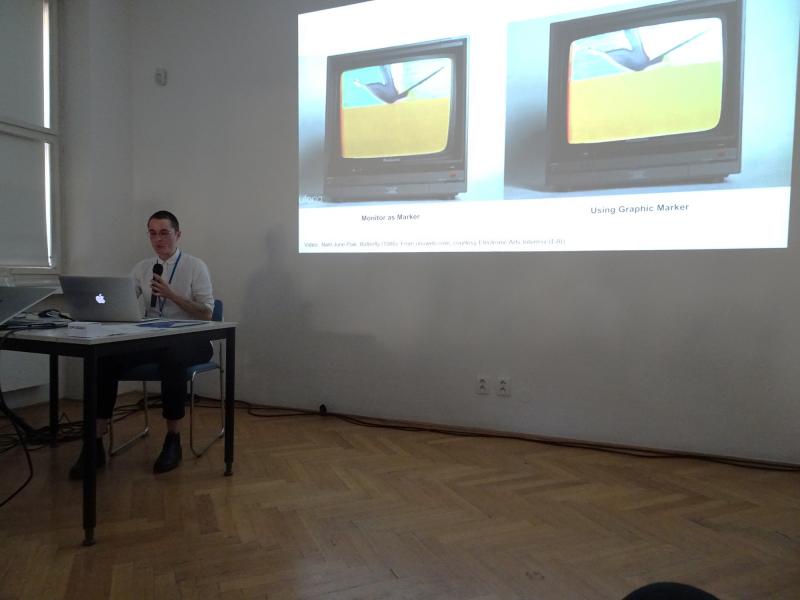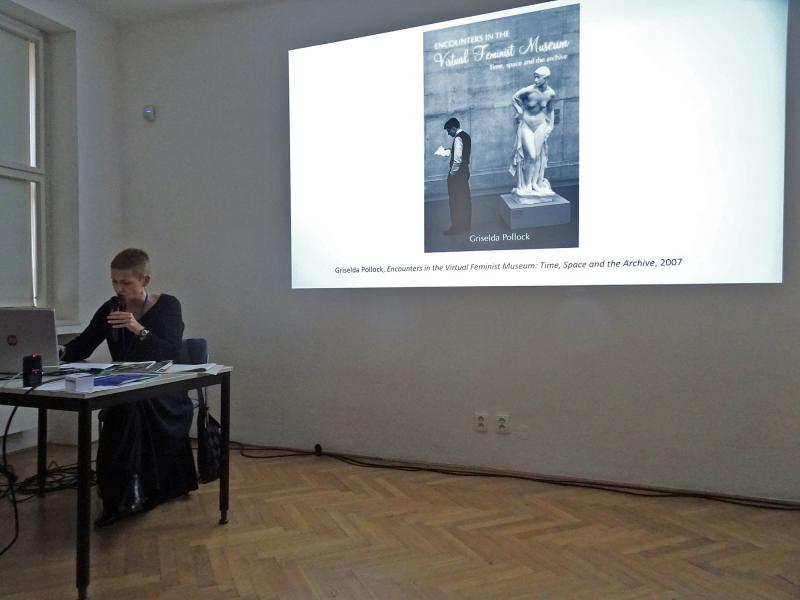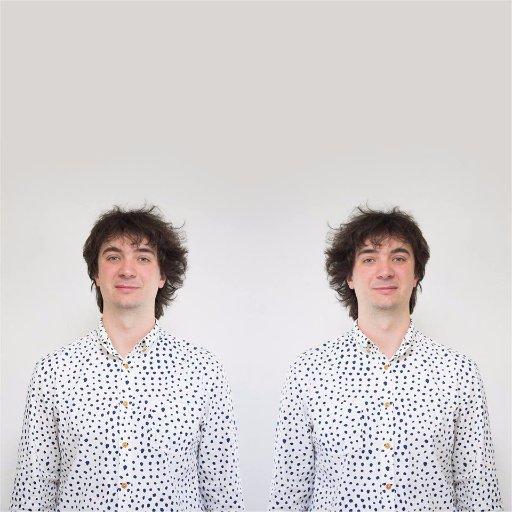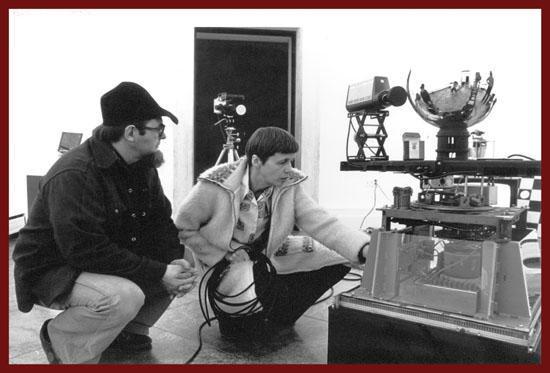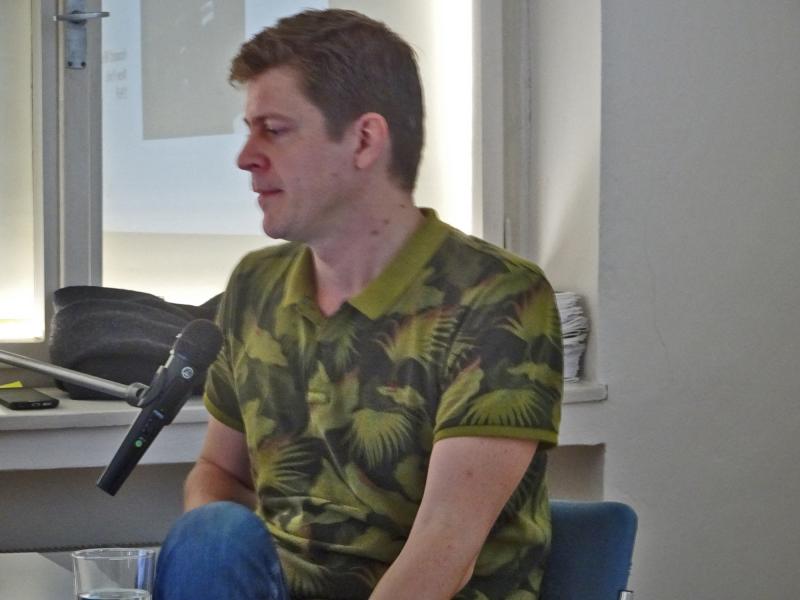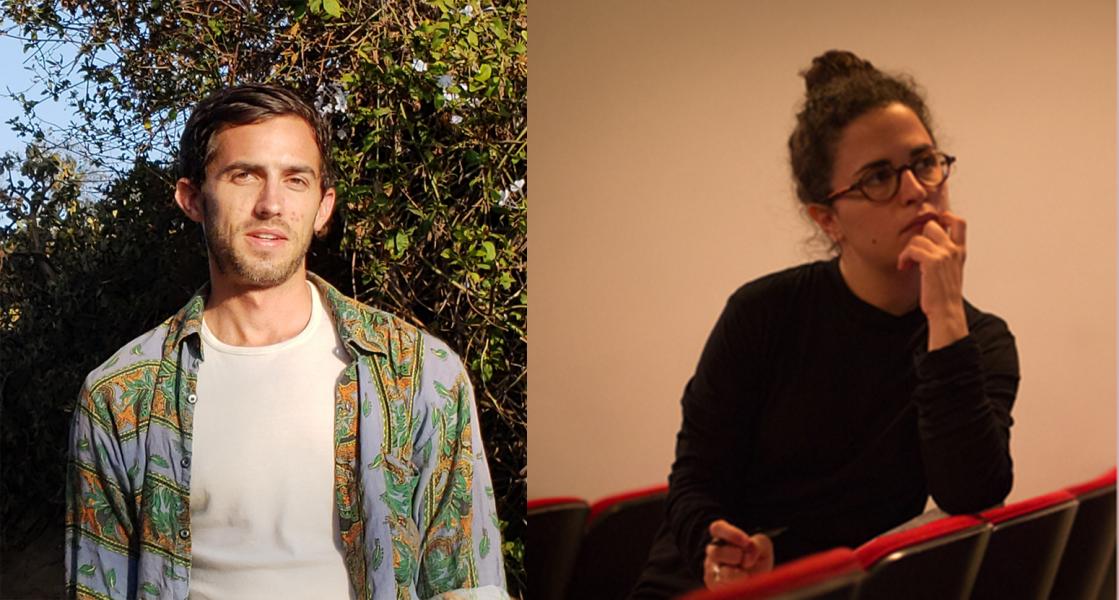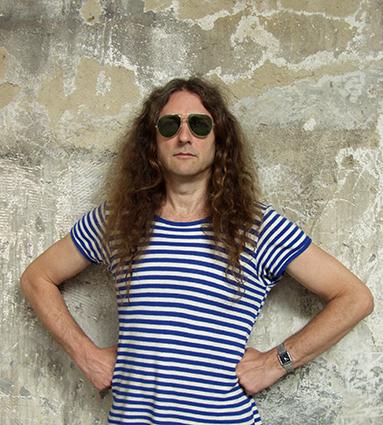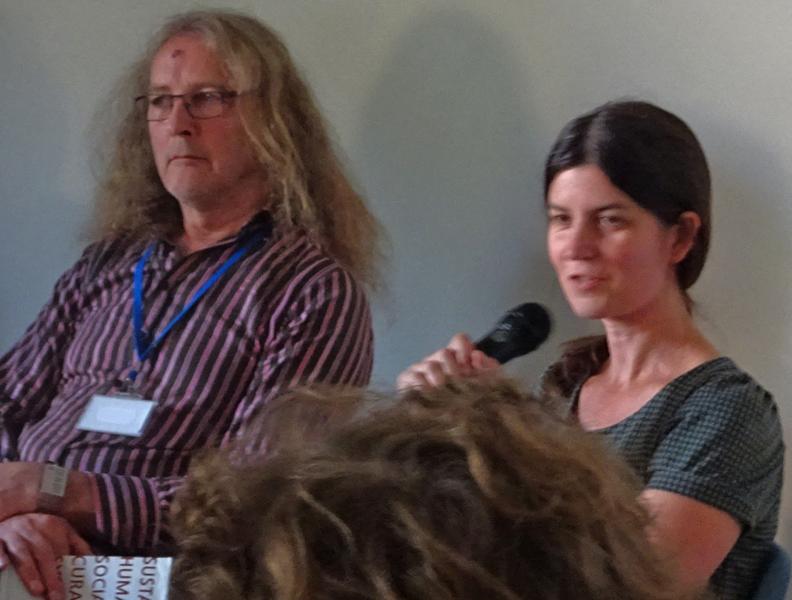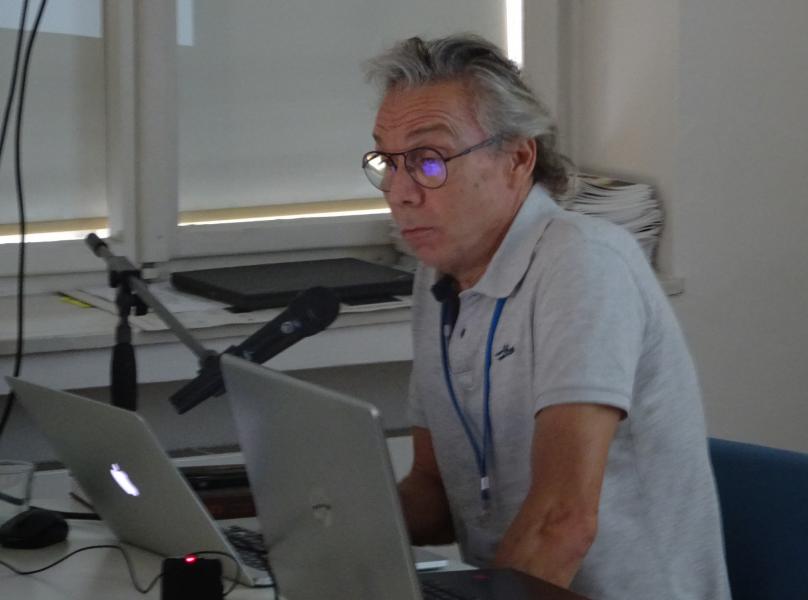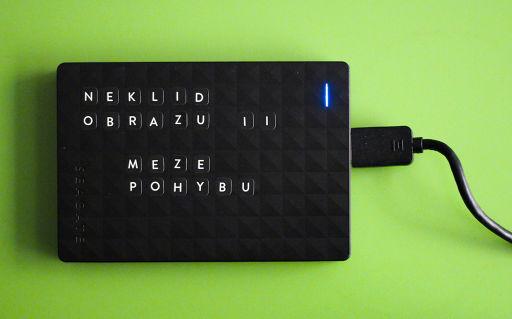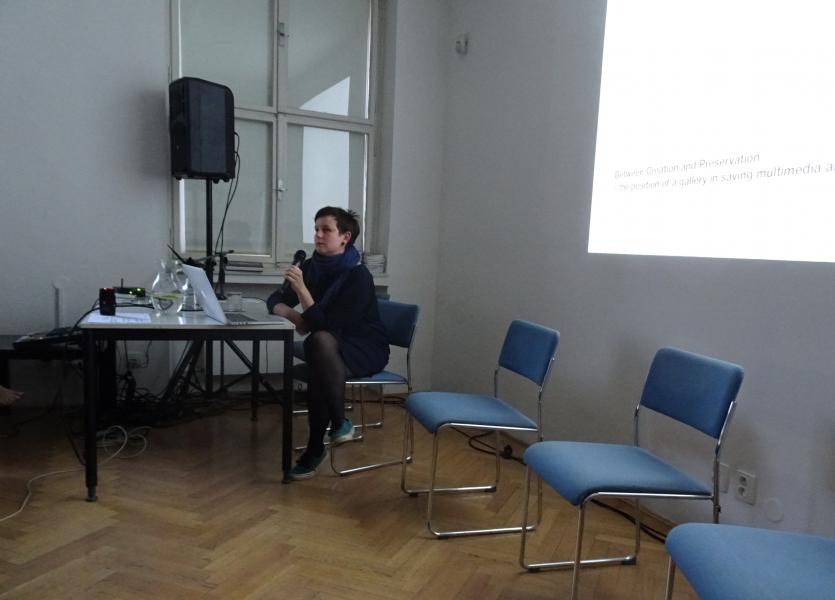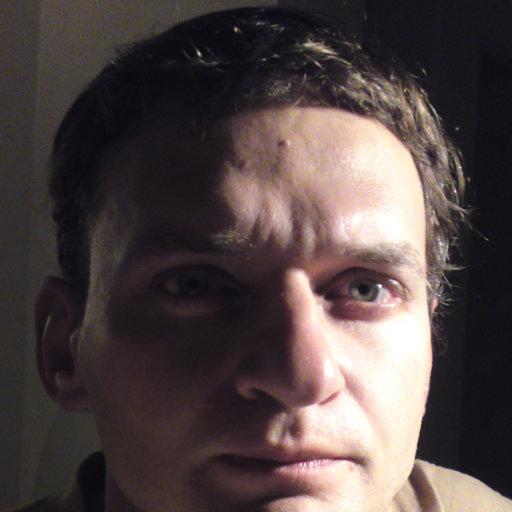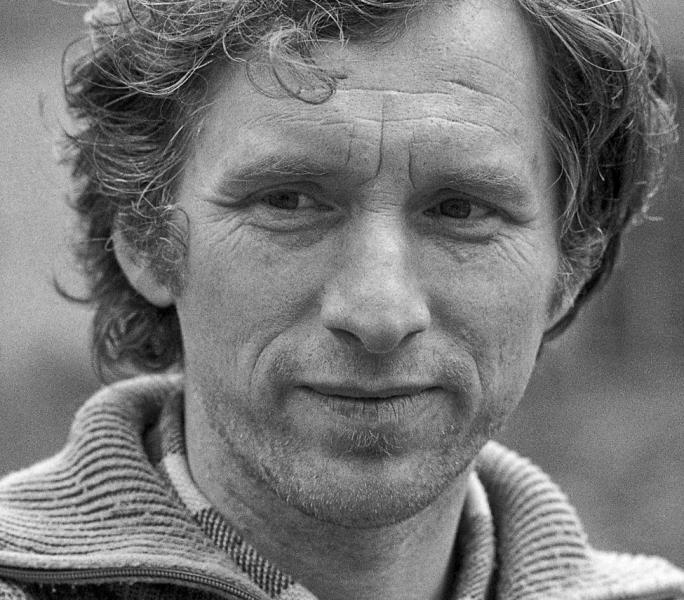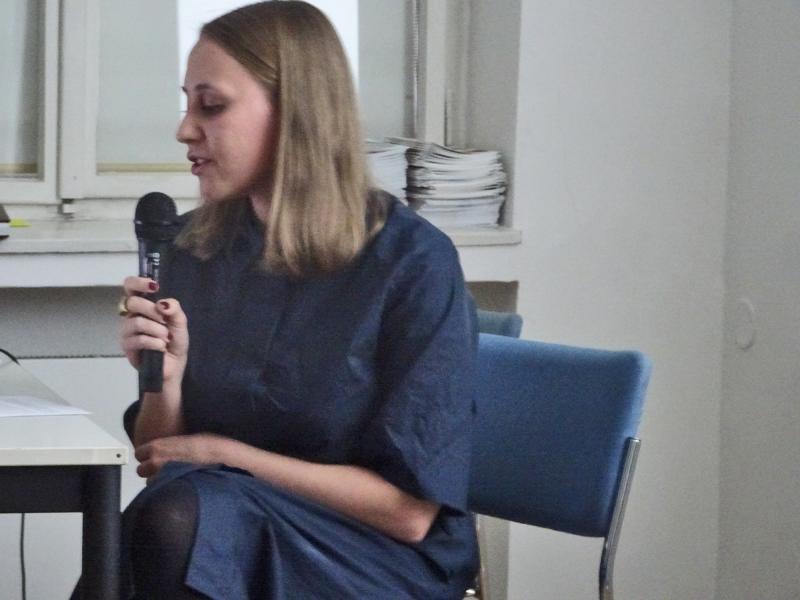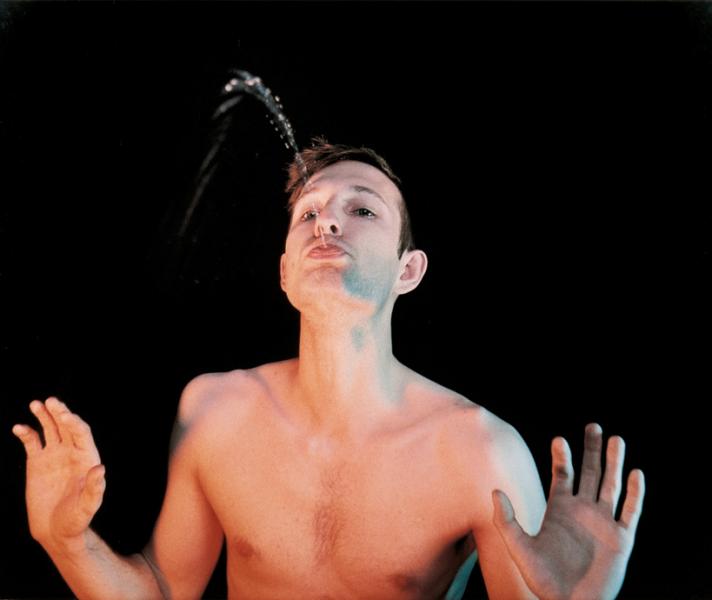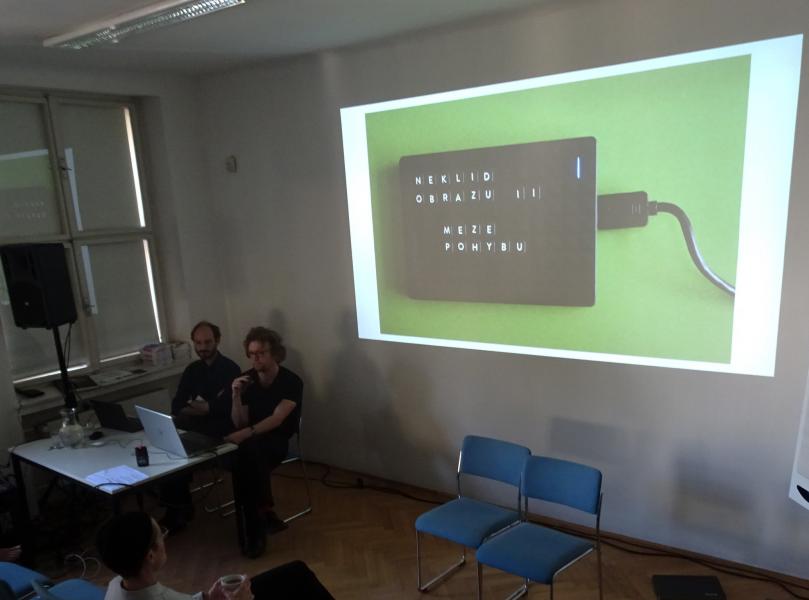Artworks from the Digital Era in Galleries and Museums
International Colloquium
The Brno House of Arts, Malinovského nám. 2
22–23 October, 2019
A mere fifteen years ago, it seemed that electronic and new media would barely become accepted by established, institutional collections of modern and contemporary art. Around the year 2000, private collectors and state galleries still seldom, and often with suspicion, paid attention to electronic art works. Artists working in electronic media, and university-level art institutions looked upon electronic media departments with skepticism. But nowadays, new media, electronic, and digital art comprises a seminal part of most respected collections.
Since the closing of the 20th century, the (art) world has changed substantially, and new media are no longer a tactic, a strategy, or a statement, but rather one of the most popular means for commenting on the condition of 21st-century humanity. Artifacts which include an element of the electronic moving image, digital code, the static technical image or sound are no longer limited to projects focusing on new media, but have become an organic component of a large number of exhibitions. Even art works which are presented within the context of the internet or computer games appear in the acquisition-oriented endeavors of galleries and museums all around the world.
Media art is, however, very dependent on technologies which are quickly becoming outdated and are hard to acquire. Many media works are thus losing their potential for being exhibited within a very short span of time, or will eventually become lost forever. We are thus threatened with the prospect that we will lose a large part of our heritage of post-industrial digital culture, since a systematic, widely accepted and satisfactory methodology for their preservation and documentation is, even in this day and age, still non-existent.
In 2018, the New Media Center – Vašulka Kitchen Brno opened under the auspices of the Brno House of Arts. In collaboration with the Vašulkas, as well as with a number of international institutions, it has confronted the need for collecting and archiving electronic artworks.
- What is the current situation in the field of state-owned and private art collections, both Czech and abroad?
- What is the situation at universities which have expertise in creating and archiving video art, interactive audiovisual installations, net art, sound art and other art forms which are considered ‘new media’?
The colloquium entitled Digital-Era Art Works in Galleries and Museums introduced and discuss current knowledge, methods and practices of managing collections in galleries and museums, mainly across Central Europe.
You can find the detailed programme and some recorded lectures below the text.
Documents to download
TUESDAY 22.10.
10 - 10.15 AM - Intro & welcome
JENNIFER DE FELICE / MILOŠ VOJTĚCHOVSKÝ
This colloquium was initiated as a collaboration between Vašulka Kitchen Brno, a recently opened space and initiative for new media art, The Brno House of Arts, and The National Film Archive (NFA) in Prague. The organizers hope to create an opportunity for sharing knowledge and models of working practices concerning both artist-led and institutional strategies for presenting, collecting and distributing electronic, digital or software-based art. What current strategies are available to secure a place for digital art among the current models of displaying, preserving and distributing audiovisual arts?
On the first day of the colloquium, two lecturers will present and discuss two examples of new media initiatives in their current situations and histories, with an outline of other related initiatives in this area: the C³ - Center for Culture and Communication of Central Europe (Hungary) and LIMA from Western Europe (Netherlands). Both institutions are part of a broader network consisting of many European initiatives and institutions focusing on promoting, collecting, preserving and mediating digital art or moving images, and can serve as a good model of a small-scale platform with extensive, long-term experience of managing and preserving collections and databases of audiovisual art, both on the national and international levels. C³ was established in 1996 as one of the major projects of the Soros Center for Contemporary Arts Network for Eastern Europe. LIMA, a platform for media art, new technologies and digital culture, was founded in 2013 in Amsterdam as a follow-up to the former Netherlands Media Art Institute. It was closed because it lost its funding. NMAI itself grew out of the gallery MonteVideo, founded in 1978 by René Coleho, which merged in 1993 with another organization called Time Based Arts. Both lecturers will share their long experience in working with new media and present their opinions on how the position of new media will develop. Marek Pokorný - the director of the Municipal Gallery for Contemporary Art PLATO in Ostrava and František Zachoval the director of the Gallery of Modern Art in Hradec Králové comment the current approaches of Czech contemporary galleries towards art of moving image, Flóra Barkóczy intruduces the Artpool Art Research Center, and amon others Martina Pachmanová challenges the process of digitalisation from the perspective of gender.
GABY WIJERS
LIMA as a platform for media art, new technology and digital culture
10.30 - 11.30
Keynote lecturers
LIMA as a Platform for Media Art, New Technologies and Digital Culture
LIMA (Amsterdam, NL) is a media art platform, agency and digital repository which takes care of 1000 ends of media artworks for artists and collections. Since 2016, we have been exploring ever more alternative ways to examine documentation and re-interpret it as an experimental but emerging practice for the conservation of media artworks. Media art is experienced through ever evolving technical media, browsers, networks, documentation and storage media. Digital art or media art, live art and performances are different from other art genres; they are dependent upon the practices rather than the objects, and upon the performative role of the spectator. Since the 1990s, the ephemerality and immateriality of much of these media art works have demanded the configuration of a new set of techniques to ensure their future transmission. However, the questions have been centered on technical responses to rapid technological obsolescence, an everlasting continuum of deterioration of materials and requirements. Therefore, with the necessity to preserve long-term custody of media art, it is necessary to look beyond the object and the medium. It is necessary to critically investigate existing documentation and preservation methods and develop alternatives.
The artistic choice for a (digital and online) medium often implies specific ideas about the future and continuity of the artist’s work. Hence, the artist can provide insight into the creative process (sometimes as the only source) and deliver technical data needed for the work’s future accessibility. In the preservation research projects of LIMA, collaboration with multiple stakeholders and artists’ interviews are common practices. Sometimes it is even taken one step further when the artist is an active participant in preservation. Management and preservation starts with the production, which is often the source of the problem as well as of the solution: the artist, the formats, associated software and hardware, the quality, selection and organization of the files, and the additional information about them, are all actors in the process of the production and future life of a digital work of art.
I’ll share with the audience questions and outcomes of projects such as the Artwork Documentation Tool, or the Do-It-Yourself tool for documentation, as well as video documentation practice and reinterpretation, in order to capture the hybrid, contextual and living qualities of an ‘original’ piece, rather than proposing an ongoing process of changing technical platforms and operating systems.
In addition, LIMA is currently updating its digital repository and workflow. With an emphasis on net art and complex digital artworks, the new repository, collection information system, and associated workflows, are tailored to capturing the mutability inherent to the life cycle of digital artworks. These methodologies, requirements and architecture are being explored in the research project Art Host.
Gaby Wijers (Neth., 1959) is founder and director of LIMA, the international platform for sustainable access to media art. Previously she was a coordinator for the collection, preservation and related research at the Netherlands Media Art Institute (NIMk), Amsterdam and head of the collection of the Theater Instituut Nederland (TIN), Amsterdam. She participates in national and international networks such as Foundation for the Conservation of Contemporary Art (SBMK), GAMA, DINAMO, Cultural Coalition for Digital Heritage (CCDD), Dutch Digital Heritage Network (NDE), is guest lecturer at Amsterdam University and honorable research fellow at Exeter University.
MIKLOS PETERNÁK
Center for Culture and Communication, Hungary
11.30 - 12.30
Keynote lecture:
Consecutio temporum beyond Grammar: The Past, Present and Future of C³
In this lecture I intend to share with you my experiences in the field of new media art, or better to say the relationship between contemporary art and the digital era, including the production, distribution, collection, interpretation and preservation of this type of artistic activity. These experiences are mainly related to the work of C³: the Center for Culture and Communication Foundation which is a not-for-profit institution based in Budapest. Since its initiation in 1996, C³ has focused on fostering the integration of new technologies within social and cultural traditions. Founded as a space for innovative experiments and developments related to communication, culture and an open society, over the last two decades, C³ has developed several layers and strategies. I try to highlight through a palimpsest-like chronology, or via the changing initiatives and attitudes, our attempts regarding the production of the new, meaning the collection of the newly digital-born entity or artwork, including the contextualisation and the preservation of the information about its existence. Furthermore, I will try to show that, from the perspective of the artwork, the creation of an institutional framework is a kind of metadata, while from the perspective of the institution the artworks could serve as the foundation or reason for its existence. Therefore, some years ago I proposed to establish a media museum based on C³ collections, databases and networks, using a shift in perspective to reshape and rebrand the institutional activity based on the past and also to think the potential future. Yet there remains an unanswered question: What is the most relevant form of a contemporary institution dedicated to the preservation and safekeeping of our digital culture, and keeping it historically accessible? Are there even any?
It is a typically human experience to follow in real time how, through the the process of ageing, the new becomes the old while practically remaining the same. This is – in accelerated form – the situation of media art works, except for the fact that these products are even more fragile than humans. Here, an obvious question arises: Is using the classical concepts of culture and responsibility in the post-information era still a tenable attitude? The question is not poetic or rhetorical, for I think the answer is 'yes.'
Miklós Peternák (born in Esztergom, Hungary, lives in Budapest) is a writer, lecturer and film/video artist. He studied history and art history (PhD 1994: New Media – Art and Science). He was a member of the Béla-Balázs-Studio, Budapest (1981-87) and the Indigo-Group and head of the Intermedia Department at the Hungarian University of Fine Arts since its foundation, director of C³: Center for Culture and Communication (http://www.c3.hu/) since 1997. He has produced films and videos in the 1980s and published texts on art and media history. He has also organized diverse shows and events.
Peternak: The Medium of Preservation
FlÓRA BARKÓCZY
Artworks and Documents in the Context of New Technologies at Artpool Art Research Center
2 - 2.30 PM
My presentation introduces the Budapest based Artpool Art Research Center’s activities in preserving and presenting experimental forms of art (fluxus, mail art, conceptual art, performance, visual poetry, sound art, fax art, etc.) from the sixties on, in the context of the developments of new electronic and digital technologies.
Collecting artworks and documents related to ephemeral art practices has been an essential focus of Artpool since its establishment in 1979. It initiated and organized several projects reflecting on the approaches of new technologies. The series of Artpool Radio cassettes of 1983-87 included sound documents of the underground art scene and sound materials from the international network. The international telecommunication project Telephone concert Budapest–Vienna–Berlin organized by Robert Adrian X and Artpool in 1983 was followed in 1993 by the electronic communication happening Danube Connection, combining the medium of fax, picture phone, video, telephone and performance. The first fax action realized by Artpool in 1992 connected artists from around the world within the frameworks of the Decentralized World-wide Networker Congress Budapest Session. The audiovisual materials generated, collected or documented by Artpool not only became part of the archive’s collection, but – based on the “active archive” concept – they have been circulating in publications, events and exhibitions conceptualized by Artpool up to this day. Artpool’s website – created in 1995 by the founder György Galántai as part of his artistic and curatorial practice – also serves as a reflection on the developments of new technologies, and at the same time presents artworks and documents from the archive’s collection.
Along with Artpool’s integration into the Museum of Fine Arts in Budapest in 2015, the archival materials became part of the museum’s collection, therefore also requiring the adaptation of new strategies in preserving and presenting the available materials, including performance videos, audio recordings, webpages, sound installations, etc. This paper aims to present Artpool’s strategies of making accessible archival materials based on analogue and digital technologies in the last 40 years.
Flóra Barkóczi is an art historian and archivist working at Artpool Art Research Center in Budapest. She studied art history at the Eötvös Loránd University in Budapest, and at the Humboldt Universität in Berlin. After finishing her studies, she worked at Robert Capa Contemporary Photography Center and acb ResearchLab, Budapest. Her research interest includes the avantgarde art scene of the 1960-70s in the East-Central European region, conceptual art, photography and the use of new technologies in art. She is currently working on a research project on internet-based art practices in the 1990s in Hungary. She regularly publishes essays, critiques and reviews in English and Hungarian.
FRANTIŠEK ZACHOVAL: Moving Image and Collections of the Gallery of Modern Art in Hradec Králové
2.30 - 3 PM
It is important that Czech regional galleries will focus on contemporary art, including the art of moving picture and so - to contribute to diversity of national heritage. Their exhibitions and aquisitions would be less dependent on politics of collection institutions in main centers.
The current acquisition activities of the Gallery of Modern Art in Hradec Králové (GMU) are to collect of both Czech and international visual art. This year we have established new "collection of moving image" to record and to reflect this field from the beginning of experimental tendencies in the 1960s to the present.
In a national and international context, we should consider or even strive to establish an independent institution, dedicated to the contemporary art of moving image and sonic arts (abroad, for example, Het Eye and LIMA in Amsterdam, Argos in Brussels, WRO in Wroclaw or the Video Forum NBK in Berlin). In addition to collecting activities, research activities, including mapping of the Central European region, could take place here.
František Zachoval is a publicist, educator and cultural manager. He is engaged on actual socio-political topics. In 2016 he graduated from the Academy of Fine Arts, where he later led the Digital Laboratory ( 2006–2014) and co-founded the international project and video online archive Artyčok.TV. He focused on topics as Creative Commons digital licenses, Open source (2008-2010), or migration and exile, for which he organized conferences. In 2015–2019 he was the director of the Czech Center in Bucharest, where he founded the Future Museum Art Gallery (2016), the Protect Public Space database (2017) and the Cinemascop Eforie Film Festival (2018). He is the editor of the publications Czechoslovak Home, Object and Items Found in Romania (2019) by Martin Papcun. Buildings / Spaces (2015) and Rudolf Valenta. Reconstruction (2014). Since 2019 he works as director of the Gallery of Modern Art in Hradec Králové.
SASCHA ARDEN : The Potential of Augmented Reality (AR) in the Virtual Performance of Time-Based Media Art
2.15 - 2.45 PM
This presentation explores the potential of AR as a tool to preserve the experience of time-based artworks no longer able to function in their original iteration due to damage, obsolescence, or other barriers. Elements such as moving image or kinetic motion could exist as virtual visual layers integrated with the original object, or alongside it. As an alternative to an exhibition copy or displaying an object with documentation of its past function, AR offers a unique method to connect time-based, work-defining elements to their physical anchors and keep such artworks accessible to viewers. By proposing the application of AR technology through case studies, some limitations will be discussed, as well as questions around ethics and authenticity.
Sasha Arden (pronouns they/them/their) is a graduate candidate in Conservation and Art History at the Institute of Fine Arts at New York University, specializing in Time-Based Media. Their previous experience includes installation of media-based artworks at the San Francisco Museum of Modern Art, managing media exhibits at the Oakland Museum of California, overseeing all audiovisual resources at the San Francisco Art Institute, and as adjunct Instructor for media production in the Sculpture Department at the School of the Art Institute of Chicago (SAIC). Sasha completed their Bachelor of Fine Arts at SAIC in 2004, and a Post-Baccalaureate Certificate in Writing at SAIC in 2005.
JANA HORÁKOVÁ: Towards an Augmented Media Art Historiography
4 - 4.30 PM
Keynote speaker
Utilization of Artificial Neural Networks in the Analysis and Mediation of the Content of Steina and Woody Vašulka Archive
This paper presents the applied research project Media Art Live Archive: An Intelligent Interface for Interactive Mediation of Cultural Heritage supported by the Technology Agency of the Czech Republic (TA ČR). It is conducted by scholars from Masaryk University and Brno University of Technology in coordination with these external partners: the Center for New Media Arts – Vašulka Kitchen Brno and the Brno House of Arts. The main goal of the project is to develop artificial neural networks capable of effectively enhancing and/or innovating research methods applied to early video art. In addition to the experimental testing of IT tools in the media arts historiography, our goal is to develop proper interfaces which can convey early video art poetics to a contemporary audience.
This presentation will focus on the conceptual background and hypotheses determining the overall design of the research project. Answers to the following questions will be presented: What is the current situation regarding the preservation, archiving and mediation of media art? Can artificial neural networks serve as analytical tools applicable to new media art, especially video art? What known research methods do they simulate and what can they bring about from a methodological point of view? Partial knowledge and results of the research project will be presented.
Jana Horáková works as an associate professor (habilitation in aesthetics) at the Institute of Musicology, Faculty of Arts, Masaryk University and as head of the Theory of Interactive Media study program. She graduated from the Dance Conservatory (secondary school), and after five years of being a member of the ballet company of the National Theatre in Prague she graduated in Theatrology from Masaryk University. Influenced by a study visit to the Media studies department of the University of Lapland (Finland), she began to study new media art with a focus on theatrical projects conducted in virtual reality and on robotic art and robotic performances. In recent years, she has focused on mapping new media art transformation following the burst of the so-called 'dot-com bubble', which manifests itself by establishing new academic subdisciplines: critical code studies, software studies, platform studies, etc. She conducted research into the relationship between living art and media, and in their archiving and mediation, as well. Most recently, she has been exploring the potential of IT in the historiographic research of new media art (see the virtual reconstruction of the Computer Graphic exhibition curated by Jiří Valoch in 1968, Computer Graphics Re-visited, the Brno House of Arts 2017, 2018) and now she leads a research and development project in which artificial neural networks are trained and interactive interfaces developed to serve in the analysis and mediation of the Vašulka’s video archive.
Jan Horáková: Towards an augmented media art historiography
MARTINA PACHMANOVÁ: Matrilineal Digitization?
4.30 - 5 PM
Although museums of art have been challenged for decades to correct their master narratives and to implement inclusion, they mostly remain rather immune to critical – feminist but also post-colonial or queer – strategies. Representation of women in museums and their permanent or long-term exhibitions continues to be in flagrant disproportion comparing to their male counterparts which does not apply only to former Eastern Europe. Following the “virtual feminist museum” which, as a utopian project, was formulated by Griselda Pollock in 2007 as a response to the surviving gender inequality in museums, the presentation focuses on the potential of digitalization of art for a radical transformation of patriarchal museum structures. The appeals as well as risks of such strategies will be reflected on examples of selected museum projects of digitalization of older art works and archivalia related to the matrilineal art tradition (which was often related to the moving and flickering images in the post-war era) but also on examples of independent and decentralized platforms that work with digitalized and/or digital artefacts of, mostly, contemporary women artists.
Martina Pachmanová is an art historian, theorist and curator. As an associate professor, she is affiliated with the Department of Art Theory and History at the Academy of Arts, Architecture and Design (UMPRUM) in Prague. She specializes in gender, sexual politics and feminism in modern, post-war and contemporary art and visual culture, including design.
MARTINA PACHMANOVÁ: Matrilineal Digitization?
LUKÁŠ PILKA - How Does the Machines Perceive Art? - Digital Art History and Machine Vision
5 - 5.30 PM
Today every work of art is digital. Even gothic panel painting or baroque sandstone sculpture has its virtual reproduction, which represents it and which becomes the object of our observation. New forms of representation are associated with new forms of research; In 2015, Lev Manovich described Digital Art History as a set of methodologies using quantitative analysis to explore cultural artifacts. As a new attitude to history, which access cultural databases, digitized museum and archive collections, metadata, texts on art, and virtual reproductions of art works through mathematical and statistical ways. The exponential growth of computing capacity and the increasing volume of (and not only) open cultural data make it possible to conduct surveys that have been difficult to imagine in the recent past.
One of the methodologies in digital art history is represented by visual analyzes based on current technologies of machine image recognition. What stimuli does it bring? And what can we observe in works of art? Recent experiments suggest that synthetic vision may not only be a useful tool for classifying artifacts, but a full-fledged medium of conveying new perspectives. It is a continuation of formal analysis, the evolution of the comparative methods used by Winckelmann, Riegl, Wickhoff, Warburg or Malraux, which have been present in modern art history from the very beginning. Today, however, we can automate the vast array of digitized reproductions.There is a way to search large image files, to compare entire collections managed by different museums, to navigate the collections of distant foreign institutions as well as we move around home. There are many opportunities that digital vision brings to the history of art, but this nascent method suffers from a number of birth problems, which I will also mention in the paper.
Lukáš Pilka is a designer, critic and journalist dealing with digital design, contemporary technologies and the overlap of both into the world of fine art. Within his doctoral research at the Academy of Arts, Architecture and Design in Prague he is interested in using neural networks for the quantitative interpretation of classical works of art. He is a co-founder of the Alt Tab think tank, which maps the intersections of design, ethics and technology.
5.30 - 6.00 PM discussion/coffee break
6 - 7.PM BASTL INSTRUMENTS
WEDNESDAY - 23.10.
DŮM UMĚNÍ
On the second day, the program will focus on current discussions of mostly practical, although partly theoretical, issues related to the application and development of digital tools as databases of art collection, and/or on different strategies of sharing in order to offer public access to a body of cultural heritage.
Archiving and sharing was one of the main subjects of Woody and Steina Vasulkas' approach since the beginning of their engagement with electronic image and tools. In this respect, what is the media landscape today like after 50 years of new media history?
A lecture by the founding editor of Monoskop, the platform for collaborative studies of art, culture and media, and initiator of the networking cultural structure Multiplace will reflect on recent initiatives, approaches and tendencies in the field of preserving media art as media installations and digital art. Media art historian and theorist Jana Horáková (Masaryk University Brno) will present a current research project applied to the digital archive of The Vašulkas.
DUŠAN BAROK: New Approaches in the Conservation of Contemporary Art
10 - 10.45 AM
Keynote lecture
Following the early work in video art preservation in the 1980s and the 1990s, the efforts to preserve media installations and digital art, and more recently net-based art, contributed to raising the prospects for preserving the media arts at large. Apart from independent initiatives and private studies, a number of contemporary art museums have established media labs and adjusted working methods to address these new demands. However, this is still viewed as a luxury for most collections of media arts in the East and West, often lacking funding, infrastructure and expertise. The work not only requires an openness to a certain aesthetic, a technical and caring sensibility, but also unflinching advocacy for its relevance, inside and outside the collection. In this lecture, I will reflect on recent initiatives, approaches and tendencies in the field through my experience as a research fellow in the EU Marie Skłodowska-Curie-funded training network New Approaches in the Conservation of Contemporary Art (NACCA).
Dušan Barok is a research fellow and PhD candidate at the Media Studies Department of the University of Amsterdam. He is founding editor of the platform for collaborative studies of art, culture and media, Monoskop, and his practice involves networked media, participatory events and experimental publishing.
For recent publications see
FLAMINIA FORTUNATO / JOEY HEINEN, There is no “I” in iOS:
Cross-institutional collaboration in preserving iOS media
10:45 - 11.15
Within recent years, technology and new media has taken some surprising new turns which are challenging media collection caretakers in their quest for best-practices in preservation. Among those, live simulations, Augmented Reality iOS Apps, mobile Apps, and Apple devices are making their way into museums collection. Often these works rely on proprietary technologies and the support of tech companies which have little interest in sustaining their tools in the long term. In fact, these tools by design appear to resist conventional processes of stabilizing the media due to the inherent need to maintain licenses, refresh the media along with incessant system updates, and use proprietary back-up and analysis tools which allow for examination of the device’s inner-workings. While issues in preserving proprietary technology is not new within Time Based Media, these added barriers are further solidifying a need for creating collaboration as a means of combating these issues.
Establishing a dialogue with the artist and their assistants/fabricators/software developers has become a key aspect for shepherding these works into museum collections and for gaining a better understanding of what the artist’s deliverables are and what the museums will be responsible for preserving. Often, a fully-formed understanding of the work and its ongoing care involves cross-departmental collaboration between curatorial, registration, exhibition design, conservation and audio visual technicians. This specific institutional endeavor is particularly important when more complex media works are being acquired.
In what ways have these objects challenged our approach towards caring for Time-Based Media and what are some strategies in ensuring that these works are sustained across various stakeholder groups? What are the significant moments in the life-cycle of these works that will help collecting institutions in better understand their vulnerable nature and ultimately making decisions about their future care?
This presentation seeks to unravel these questions through the use of few case studies and a year long joint effort between the Los Angeles County Museum of Art (LACMA) and the Museum of Modern Art New York (MoMA). In 2016, Composition for Marimba (2016) by Mungo Thomson was acquired by the LACMA. This work consists of a mobile phone mounted on a tripod which acts as a set piece and audio-visual display device. An iOS mobile app displays a random sequence of images of playing cards which are linked to audio files playing marimba tones and then sent to wireless speakers in the space. In 2017, WYD RN (2017) by Martine Syms was acquired by the MoMA. The work is an Augmented Reality iOS downloadable App which acts through a randomized facial recognition mechanism on a set of twelve archival pigment prints on found posters that were installed in the exhibition space. As part of the installation Incense, Sweaters & Ice (2017) this work was downloadable for visitors during the show and was conceived as a bridge between the posters and the videos installed as a means to create a conversation between these elements.
In examining case studies in conserving iOS mobile app artworks during which LACMA and MoMA were involved in collaborative research, we gained a stronger understanding of the unique risks posed in preserving media that relies on devices that are increasingly more diffuse. We have learned that mobile technologies are in many ways a moving target, resisting constancy in terms of ownership, destination platform(s), and related dependencies. This further complicates our understanding of best practices in preserving software-based art. Stemming from this understanding, we see institutional context as key, particularly in developing policies around conservation decision-making and in defining the identity of the work as it unfolds in its different manifestations. Identifying the core identity of the work will inevitably involve a privileging of certain functions. Based on the complex task of preserving such technological artworks, ongoing preservation cannot take place within an institutional vacuum, and this notion of collaboration continues to be essential. This presentation ultimately seeks to highlight how our respective institutions responded to these challenges and developed procedures for properly determining shared practices, understanding that we all have different vantage points on what forms our collective understanding of the work.
Joey Heinen is a digital preservation and time based media specialist, currently serving as Digital Preservation Manager in the Collection Information and Digital Assets Department and head of the Time Based Media Committee at the Los Angeles County Museum of Art. He graduated from the Moving Image Archiving and Preservation MA program at NYU in 2014. During his tenure he worked in NYU's film preservation lab, digitized audio for Anthology Film Archives, and served as a media collection and digitization assistant for new media artists Steina & Woody Vasulka. Following this he was selected for the National Digital Stewardship Residency at Harvard Library. He currently serves on the American Institute for Conservation's Electronic Media Group board as Secretary/Treasurer and the planning committee for the TechFocus conference.
Flaminia Fortunato is a Andrew W. Mellon fellow in Media Conservation at the Museum of Modern Art (MoMA) New York. As part of the Media Conservation team at the museum she is involved in day to day acquisition, documentation, installation and conservation of the media collection. She holds a MA in Conservation-Restoration of Modern Materials and Media from the University of the Arts Bern, Switzerland and a BSc in Chemistry for Conservation-Restoration from the University Ca' Foscari in Venice, Italy. She was a summer intern at the Hirshhorn Museum and Sculpture Garden in Washington D.C, a media conservation resident at the Museum of Contemporary Zagreb and she worked as a contemporary art conservation assistant in private practice in Italy.
ANNA OLSZEWSKA: Re:Senster Poject
There is a Script-to-Design Path that Leads Through the Media Art Restoration Maze
11.15 -11.45 AM
The turbulent history of Senster, a large cybernetic sculpture designed by Edward Ihnatowicz in c. 1970 is a classic example of pioneering media artwork saga. Divided into two periods, the creation and prematurely cancelled display (1968-1974) and its recent reactivation (2017-2018), the history provokes questions on continuity and authenticity of the lost and found pieces. For this reason, I take the recent experience of Senster’s reactivation as a starting point for discussion on the maintenance and display of media art. Reflecting on the lifecycle of the piece I propose a script-to-design path for consideration in the broader context of the art conservation strategy. I intend to argue that once a piece is set to be recreated in a reliable way, a meticulous assessment of the engineered components should precede the study of the freely designed structure. Referring to the outcomes of the Senster reactivation process, I would like to show that in a preliminary phase of the process it is highly profitable to observe the engineered (script-based) structures in every detail and do the most meticulous reverse-engineering possible, no matter whether it relates to the control system, mechanics or construction engineering, since the engineering components are a priority in dictating the scope and sequence of the restoration project and a benchmark for the reconstruction of the freely designed elements. I expect that various configurations of script and design qualities would characterize a broader class of hardware-based interactive systems restoration projects.
Anna Olszewska's background in Arts and Humanities. She has experience in the visual studies, image analysis, print history, history of science and curatorship, and worked for the Print Room of the Polish Academy of Arts and Sciences as well as the Faculty of Humanities at the University of Science and Technology in Krakow. She has a PhD degree in Art History (Jagiellonian University, Kraków), and an MA degree in Art History and Religious Studies (idem.). She works on projects connected with the performative function of images and the history of science. She is the initiator and curator of the Re:Senster project.
Documents to download
Anna Olszewska - Re: Senster Project
Tomáš Lahoda: Ethereal Body
11.45 - 12.15 AM
In contemporary art, there is an increasing number of artworks made of ephemeral, unstable and easily degradable materials. These are very difficult to stabilize or consolidate in order to stop their unavoidable degradation, or at least prolong their lifespan. Due to this, their preservation and restoration is often very problematic. Furthermore, in many cases, there is a discrepancy between two contradictory standpoints – the intentions of the artist versus the responsibilities, wishes or interests of the stakeholders, owners, or those who are in charge of the preservation. This is especially the case of museums. Artworks are often created by the artists with the intention that they will deteriorate, and the change of materials and their degradation is part of their intended meaning.
This presentation deals with one such example, presenting an artwork where the consolidation, and the preservation of the work as such, presents an almost unresolvable Hamletesque question – the dilemma of the consolidation and prolongation of its agony, or the inevitable complete replacement with all the consequences, may it be ethical, aesthetic or philosophical. Furthemore, problems of another level will also be briefly outlined – such as the individual personal evaluations and conceptions by various professionals on the same artwork which may be completely at odds to each other, as well as the changing intention of the artist/author and of their work in time.
Prof. ak. mal. Tomáš Lahoda (born 1954 in Prague) is an artist, teacher and restorer. He graduated from the Academy of Fine Arts in Prague, from 1993-1998 he was the head of the Painting Studio at the Jutland Academy of Fine Arts in Arhus, Denmark, 2007-2012 head of the Painting I studio at the Faculty of Fine Arts, Brno University of Technology. Since 2013, he has been lecturing on restoration of modern and contemporary art at The Faculty of Restoration of the Pardubice University.
Tomáš Lahoda: Ethernal body
LENKA DOLANOVÁ: The Obsession for Archive - W+S Vasulka
13.15 - 13.45 PM
In the beginning there were collecting physical objects from airports and military junkyards, kitchens and back yards, to document the coexistence of art and electronic media. Gradually followed by the desire to collect, to disassemble, to sort, to analyze and - above all - to share. The lifelong obsession for Archive - an utopian space to live in, for sharing, collaborating with others - meandering from studios, universities labs, foundations, new media centers, towards online archives, databases and virtual 3D worlds.
Lenka Dolanová (born 1979) is an art historian and curator, she works at the Regional Gallery in Jihlava [OGV], where she is responsible for the collection of print materials and new media, the IGLOO sound gallery program and the editor of journal O_kraj. She is a member of yo-yo association, KRA - Kravín Rural Arts and Vasulka Kitchen Brno. In her spare time, she works in a café in the cultural area of Zastavkafe in Chotěboř. In 2011, she published a book Dialogue with Tool Demons - Steina and Woody Vasulka (published by NAMU and JSAF).
Lenka Dolanová: Obsession for archives, W+S Vasulka
FREDERIC CURIEN: The processing of the Vasulkas archive
Between Conservation and Activation
1.45 - 2.15 PM
The SLIDERS_lab [Frederic Curien, Jean-Marie Dallet] is a collective artists who had worked with Steina and Woody Vasulka since 2013. With them and also separatly this group proceed the processing of the Vasulkas archive following two strategies:
conservation — update, creation of new entities — and activation — Reinterpretation as the exploration of the past from the present, devise other futures.
1 – Conservation
1.1 – Update and creation of new pictures
‘Update’ means the possibility of improving the original digital file quality by rewritting it with new softwares. In fact what could be consider as a mild transgression of the ‘original’ is an update or more an ‘actualization’ of the digital folder. I've used this strategy of conservation with two series of Woody Vasulka's artworks, Time/Energy Objects (1974) and Lucifer’s Commission (1981). I indeed have organized a production of three sets of twenty-three pictures of these images with the Liedts-Meesen Foundation (Ghent, Belgium) and Fresnoy Studio (Roubaix, France). The first part of this production allowed us to improve Woody Vasullka’s original files with a specific work on Adobe Photoshop software. This step prepared the development of two new photographies series with a Durst Lambda machine that have increased Woody Vasulka's artwork.
1.2 – Creation of a new archive place
VIM (Vasulka Interactive Multimedia, 2013-2019) is an interactive archive console organizing the navigation in a Vasulka’s database containing more than four thousand documents: texts, discussions, drawings, programs, catalogues, photographies, videos, and more. These documents are classified by creation and placed on a virtual cylinder that are all arranged one above the other building an archive tower. The viewer can turned these cylinders to the left or right from three touch screens placed vertically to consult the views. Then you had, again, three touch screens arranged horizontally on the furniture. The one on the far left showed an enlargement of the consulted image, the one in the middle showed a video of the creation, while the one on the far right presented a cartel with a title, the year of creation, the inventory number and more. There is also an internet connection that allowed anyone who is authorized to connect to the database and add informations.
2 – Activation
2.1 – Reinterpretation as a new fiction
In this case reinterpretation is a creative act that interrogate the original to move it in new fictional territories. Lucifer’s Commission (2015) belongs to this class. Three films were made using the images from the Time/Energy Objects and Lucifer's Commission series. Each are separatly projected on three big screens hanging and attaching with each other. The first is a journey to the confines of a universe with the passage inside a white cubic construction, a pixel lost in the universe. The second reuse the Time/Energy Objects serie’s images. These have been placed on two cylinders in rotation arranged one above the other. On the top one, an extrusion effect have been applied that gave the impression that the photographs were composed before our eyes. Then this global form have been duplicated and showed further into the virtual space and we then invented a path in these memory architectures using a camera whose trajectory had been programmed. The third is a carousel composed of photographs folded to form cubes. The carousel turns, the spectator passes through walls of images and the round of the different structures invites the observer to an endless journey as close as possible to the frame of Woody's images.
2.2 – Rearticulation of artistic thought
This rearticulation is also a reinterpretation from which one tries to understand the original. In our case, we wanted to interrogate how digital language and ALU (Arithmetic Logic Unit) logic supported by Woody Vasulka’s Syntax of Binary Images (1978) were potential carriers of new poetics. In time, we developped a multisensory fields of activity around the concept of ALU and tested the capacity of this artwork to generate networks of relation that interconnects different versions of it. First we created a video, Digital Vocabulary (2015), with the photographic plates of Syntax of Binary Images and placed them in a virtual space where a camera hovers over them, moving closer and then away again, transforming the whole into a landscape of data. Secondly the 256 forms of this film are captured in their movements and printed using a 3D printer and then left on a light table. The virtual becomes real and is incarnated in forms. Third we placed spectators in an interactive space where these movements generate the videoprojection of Boolean matrices with a soundtrack attached to them.
Frédéric Curien is a composer and sound artist, he teaches at the ÉESI and at the University of Poitiers. He runs the bassoon instrumental space Cartography project, and takes part in the Arcad program with the Acroe, whose aim is to integrate physical and theorical tools based on physical modelling into fine arts. Frédéric Curien develops the audio part of SLIDERS, a collective attempt of interactive cinema. The project is supported by the D.A.P., Research and Innovation department.He operates at the very junction of music and visual arts, on aesthetic quality of interactive sound and musical space in contemporary art. He takes interest in sound synthesis and composing environments, and produces music for film, concert and stage.
Frédéric Curien: The Processing of the Vasulka’s Archive: Between Conservation and Action
KRYŠTOF PEŠEK / MATĚJ STRNAD: Etcetera media library and the Limits of Motion
3 - 3.30 PM
Etcetera is a free software media library enabling off-line access to audiovisual works or their representation in a gallery setting. Etcetera is based on the Linux distribution with a user interface serving the needs of the gallery's study-desk.
The media library came to being as one of the outcomes of the exhibition series Restless Image: Limits of Motion, organized for the Etc. gallery in Prague by Anna Remešová, Alžběta Bačíková, Markéta Jonášová, Matěj Strnad and Kryštof Pešek.
The project aimed to make previously exhibitied works accessible and discuss the ways audiovisual works are dealt with in Czech institutitions.
Matěj Strnad (1989) is an audiovisual archivist, working as the Head of Curators at Národní filmový archiv, Prague. Previously, he was responsible for managing the institution's digital restoration projects and collections development. He is a graduate of the Center for Audiovisual Studies at FAMU Prague, and a member of the Programming and Access to Collections Commission (PACC) of the International Federation of Film Archives (FIAF).
Kryštof Pešek (1986) is an artist, programmer and free-software advocate. He is a graduate of the Center of Audiovisual Studies at FAMU Prague. His artworks are mostly based on custom software or hardware tools. As a lecturer, he currently gives courses at the Academy of Fine Arts in Prague and works in the digital laboratory of Národní filmový archiv, Prague. He is a proud member of the live-coding group called Kolektiv.
3.30 - 4 PM discussion / coffee break
Matěj Strnad: The Limits of Motion
CAROLIN POMMERT: Between Creation and Preservation
The position of a gallery in saving multimedia art for the future
3.45 - 4.15 PM
By taking a closer look at two to three example works which have been created and/or managed by a gallery, I want to illustrate the workflow and possibilities of an internationally active gallery in the field of preservation. Most of the galleries do not have a conservator (specialized in multimedia art) in their team and do not confront future problematics with this kind of art work. As a result, many multimedia pieces degrade and technical equipment, such as VHS-recorders, camcorders, 16mm film rolls, or CRT-monitors, age in wooden crates without anyone taking notice. After some years, new solutions need to be found to make it possible to reinstall the art works again.
Often, digitization and new technical equipment is needed in order to retain the possibility for reinstallation. But this comes with an actual change to the art work, one which the artist needs to authorize. Technically, as long as the artist is fine with the "redesign" of their artwork, it is not a problem, but on the other hand the gallery pushes the change of an art work in order to exhibit and potentially sell it. At the same time, there is not enough time to do proper research and conservation of the art work's hard- and software, which could yield the truth as to the original experience of the viewer. While these changes happen in discussion between technicians, the sales team, the artist liaisons and the artists, the documentation of the actual "preservation" process is not recorded. After finishing a project, rudimentary notes are saved in a database and, most of the time, technical information is only transferred verbally. This means that if one team member leaves the gallery, the knowledge of his work leaves as well and it probably will not be handed over with the art work to future collectors and conservators. Apart from the hardware, the databases and file types also need to be checked and managed for preservation, which is also not the main focus of a gallery. Instead, the gallery focuses on file types and data transfer in the present, but only rarely keeps the future readability of those files in mind.
As a trained conservator of photographs and multimedia art, and after working for numerous museums, I was confronted with different views on the preservation of art works in the gallery context. I tried to find a way to sensitize my team to the preservation of multimedia art works, but also started questioning myself about the conservator's role. A gallery is a commercial enterprise which needs to generate money to be able to produce art, and preserving multimedia art (and art in general) is not a main topic for galleries at the moment. Should it be?
Carolin Pommert is a freelancing conservator of photographic and audiovisual heritage, Head of archive and preservation at the contemporary art gallery neugerriemschneider - Berlin.Master's degree: Entrepreneur NOVIA University of Applied Science, Jakobstadt (Finland), bachelor degree: Restoration / Conservation of Audiovisual and Photographic Heritage University of Applied Science, HTW-Berlin.
Christin Pommert: Between Creation and Preservation - the Position of a Gallery in Preserving Multimedia Art for the Future
Michal Klodner: Společensky spolkové udržitelné kurátorství
Social Federated Sustainable Curating
Documentation of works of art and related events, as well as their presentation, takes place using social media. They are often the primary source of various forms of moving image, algorithmic art or net-art. They are used not only by artists, but also by curators, galleries and memory institutions. And they are used participatively by the public.
There is a developed free software infrastructure that allows both smaller and larger institutions and individual artists to run their own nodes of federated social networks. And there are living artistic communities that have already adopted these networks because they do not accept corporate platforms for many reasons.
The open-source software provides features for artistic digital infrastructures and, using protocols like ActivityPub or Zot, creates decentralized networks of social communication and distribution between all installed nodes and channels. Participative administration in local conditions is more in line with real human relationships.
Federated social media can also be called low-power media, running on minimized resources such as Raspberry Pi with low resource requirements and low consumption, suitable for a sustainable model of operation.
Their potential lies in a large number of interconnected publication and curatorial nodes, which can also be mutually backed up or temporarily and permanently substitute each other, which corresponds to the organizational model of cooperation of independent and established cultural institutions and building alliances of care.
Michal Klodner works in the field of visual and audiovisual live performances and independent film. As an assistant he worked at FAMU film school and completed his doctoral studies on the subject of postmediality there. He is involved in digital curation of film archives and research in the field of documentation, presentation and analysis of moving images.
MILOŠ VOJTĚCHOVSKÝ: Colorum Naturae Varietas - a Collection of Colors and Scents
A Personal Note - Obituary for Dead Media
4.15 - 4.30 PM
The "artistic compact disc" COLORUM NATURAE VARIETAS was released back in 1999 in Prague and Budapest and its authors believed it was possible to compress an extensive material collection of colors and pigments of the artist and performer Miloš Šejn into about 700 MB (volume of CD-ROM medium). The architecture, design and aesthetics of the disc were based on the principles of expanded media and synesthesia - merging of text, image, sound, film and video documentation of performances into a single interconnected Archive. The project was created as a co-production between the Center for for Metamedia Plasy, the Center for Contemporary Art in Prague and C3 in Budapest.
Unfortunately, CR-Rom was at this time rather quickly disappearing from the scene, both as commercial product and artistic tool. And the rapid development of computer technology sent the Colorum Naturae Varietas to the rank of digital waste.
Miloš Vojtěchovský (born 1955 in Prague) is a curator and educator. He studied aesthetics and history of art at the Philosophical Faculty of Charles University and from the mid-1970s he was engaged in experimental music and fine arts here and there. Educational and professional activities: collaboration with the Imaginary Museum Projects in Amsterdam (mediaarcheology project Orbis Pictus Revisited - ZKM 1992 -1997), he worked at the Department of Art Theory and History at the Faculty of Fine Arts of the Brno University of Technology and at the Center for Audiovisual Studies at FAMU. initiator of sonicity.cz, symposiums of the Hermit Foundation and the Center for Metamedia Plasy, Frontiers of Solitude, etc. Member of the civic asociation VKB.
TEREZA ŠKVÁROVÁ: The Impact of Digitalization on Art Museums and on their Visitors
4. 30 - 5 PM
Digitalization is a new challenge for art museums. The current museum visitors find themselves more and more exposed to digital reproductions of artefacts - not only on the Internet, but also in exhibition spaces. In my paper, I will reflect on how this development has influenced the visitors, and focus on the application of new technologies in the preservation and presentation of artifacts, as well as the representation of museums and galleries themselves, in the 21st century.
Tereza Škvárová (Praha) graduated from the departement of Theory and history of Modern and Contemporary Art at the The Academy of Arts, Architecture & Design in Prague and art History at the Philosophical faculty Charels University in Prague. Currently she works at the Galerie Rudolfinum in Prague.
Credits and Organization
Organizers: Vašulka Kitchen Brno and the Brno House of Arts
Conception: Miloš Vojtěchovský, Matěj Strnad
Organization and production: Miloš Vojtěchovský, Marika Svobodová, Jennifer de Felice, Markéta Mazalová, Monika Szűcsová
WEB: Lloyd Dunn
English corrector: Vít Bohal
Graphics: Lucia Kolesárová/Karel Bařina
Cooperation:
Theory of Interactive Media department, Masaryk University, Brno
Department of Theory and History of Art, Academy of Arts, Architecture and Design in Prague (VŠUP)
NFA - National Film Archive, Prague
Faculty of Fine Art, Technical University Brno
Senster Genesis
The Senster, commissioned by the electronics giant, Philips, for their permanent showplace, the Evoluon, in Eindhoven, was a much bigger and more ambitious piece of work than SAM. In addition to responding to people's voices, the Senster also responded to their movements, which it detected by means of radar, and was (as far as I know) the first robotic sculpture to be controlled by a computer. It was unveiled in 1970 and remained on permanent show until 1974 when it was dismantled.
The Vasulka Effect
To give digital works a permanent place in museums, a different approach is needed. What is required to bring digital art from the past to the future? Peter Struycken is a pioneer in digital art, well-known for Dutch audiences as the designer of the ubiquitous ‘Queen Beatrix’ dotted postage stamps, common from the 1980s till the 2000s. His work is collected by many Dutch museums and is typical for the problems that arise around the preservation of digital art. Researching his work is enlightening for the treatment of digital art today and in the future. This documentary presents a number of possible approaches. This documentary has been created as part of the research project ‘Transformation Digital Art’. A project about conservation strategies for digital art by The Foundation for the Conservation of Contemporary Art (SBMK) in collaboration with LIMA and their museum partners.
Welcome to the Future! The floppy cd-rom revolution - Exhibition
Thanks to collectors, artists and media art organizations in Europe, USA, Japan and Australia, Welcome to the Future! shows a selection 100 cd-roms and floppies (including some rare items). The works are presented along 3 themes: (1) Visions, utopias and politics of the upcoming digital world, (2) New art forms and artistic digital expressions (3) Documents on contemporary arts. A fourth section deals with digital collection and heritage : (4) Heritage. This website follows the same structure (see the corresponding tabs 1, 2, 3, 4) providing introduction texts by Marie Lechner and detailled notices on the exhibited items. The last tab Interviews proposes interviews with 6 actors active in electronic publishing in the 90's: Bob Stein (Voyager), Geert Lovink, Etienne Mineur, Antoine Schmitt, Suzanne Treister and Pierre Lavoie.
